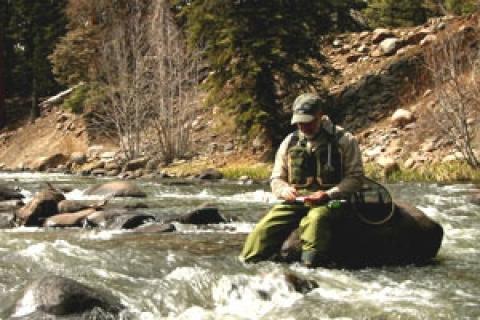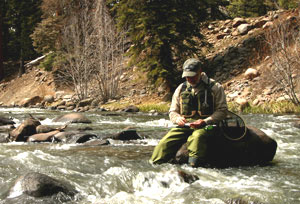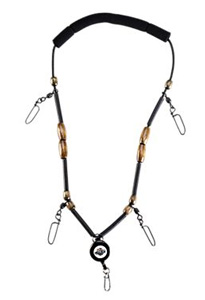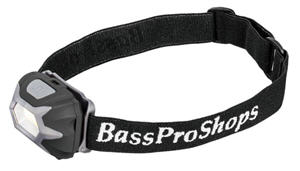
 Losing a fish is often the most disappointing event in angling (save physical harm of course), but a strong runner-up is realizing you forgot a piece of gear you needed after a long journey to your honey hole. Today fly-fishing companies have dozens of tools, gadgets, and gear aimed at keeping anglers organized, so you can spend less time fumbling through your vest pockets and more time hauling n fish. Although the simplicity of taking only a rod and a few flies has its appeal for lazy afternoon wading excursions, the gear discussed below will keep you outfitted and organized on your more serious angling outings.
Losing a fish is often the most disappointing event in angling (save physical harm of course), but a strong runner-up is realizing you forgot a piece of gear you needed after a long journey to your honey hole. Today fly-fishing companies have dozens of tools, gadgets, and gear aimed at keeping anglers organized, so you can spend less time fumbling through your vest pockets and more time hauling n fish. Although the simplicity of taking only a rod and a few flies has its appeal for lazy afternoon wading excursions, the gear discussed below will keep you outfitted and organized on your more serious angling outings.
1) Vest, Packs and Shirts
A vest holds your gear and keeps you organized when wading, so ensure you purchase a quality one. Ample pockets (in various sizes and locations on the vest) and clips, or D-rings, are crucial to staying organized. Similarly, many shirts are designed for fly-fishing and feature multiple storage pockets, and can be handy to anglers.
Packs are also available as an alternative to a fly vest. They feature pockets and compartments for holding cases and other accessories. Common examples include: waist (or fanny) packs, satchels or one-strap bags, and models resembling a reverse-backpack with the pack sitting on an angler's chest. Models will feature adjustable straps, and the benefit to satchels or chest-packs is that they can be adjusted to sit higher on the wearer to prevent them from getting wet when wading in deep water.
2) Tackle Boxes
 |
| Foam "grooves" help to keep your flies organized. |
Tackle boxes to hold flies are available in a wide array of options. Most cases today are made of plastic, versus the metal boxes of yesteryear. Less expensive cases are often flimsy and do not form a tight seal when the lid is closed, which can cause flies to get wet if the box is submerged. High-end cases will often feature a tight, although not necessarily waterproof, seal. See-through, clear plastic cases are beneficial to be able to quickly determine a box's contents and if you've found the right fly. Some cases also contain floatation material to keep boxes above water should they fall in, while others have loops to connect to lanyards. Like a lot of gear, you get the quality you pay for when choosing fly cases.
A case's interior usually features an organizing system of some sort. Compartments and foam grooves are two common systems found in cases. The former allows flies to be distinctly separated from each other and both fixed and adjustable compartment models are available. Foam grooves allow flies to be hooked into the material, accommodating flies of various sizes and ribbed foam protects hackled flies. Threader boxes are useful for carrying tiny flies and nymphs. These boxes feature compartments for bulk flies and storage space to hold threaders as well. Soft cases, or wallets, are also available to hold flies, leaders or various other flying fishing items. These items often feature soft exteriors and zippers.
Although not a case, another convenient item is a reel pouch, which covers the fly reel when it is attached to the rod. These covers provide excellent protection when your combo is not stored in a travel tube and still vulnerable to damages when moving to-and-from a waterbody. For long-term storage of rods and reels several case options exist.
3) Fly Vest Tools
Outfitting your vest with proper fly-fishing tools will make you a more productive angler. With the right gear at your fingertips, you will quickly tie flies, easily set-up your leaders and tippet, and efficiently and safely release fish. A fishing-oriented multi-tool combines many fishing gadgets in one. They often feature a hook file, a line nipper, a knot tying tool and a cleaning needle. Although multi-tools house many tools in one devise, I have found that the hook files and knot tying tools can be a lesser quality (or limiting to the angler) than the individually purchased items.
 |
| Lanyards and retractors are some of the best additions to a fly-fishing vest. |
A hook hone or file is crucial to keeping hooks sharp and hook sets successful.Anglers should invest in a good one and touch up flies whenever the hook's encountered an obstruction (e.g., rocks or wood).The knot-tying accessory on a multi-tool will not cover as many knot options as an individual tool.Most knot tools are no larger than a writing pen.Both hones and knot tools often feature a hole or clip, allowing the device to be attached to a retractor or lanyard.
Lanyards and retractors (the latter also called zingers) are some of the best additions to a fly-fishing vest. These devices hold and keep tools within reach at all times. They also act as a safety line to ensure items won't be lost if dropped in the water. Retractors are particularly useful, letting anglers use a tool that is safely connected to the retractor's cord.
Lanyards come in various models. Some are simply cords with rings or clips on their ends, while others are intricate necklace-like devices designed to hold a variety of tools and materials (such as nippers, forceps, and tippet spools). A magnetic net clip can also be classified as a lanyard. The magnet holds the ends of the lanyard together when not in use, yet once separated the net can be used, while still attached to the lanyard's cord or spiral coil.
Hook removing tools come in assorted models and should be carried at all times when fishing. Some are elongated tubes that slide down the line to the hook, pushing the barb back and out of the fish. These units come in different models to accommodate various ranges of hook sizes. Forceps are another option for hook removal. Look for locking forceps so they can be clipped directly to your vest. Pliers are also useful when targeting large fish or using big flies. Again, look for options to attach them to your vest, like a sheath or a lanyard clip.
4) Fly Vest Accessories
Some additional accessories to round out your fishing vest are as follows. A leader straightener will help remove the memory coils in leader and tippet, giving you a better presentation and increasing your sensitivity to subtle hits. A fly drier helps store and dry out flies after use, minimizing the number of them stuck in your hat. Another important item is a container that holds your fly sink or drying shake. Often vests feature pockets for these tubes, but small holders are also available to keep them within reach. Bringing a measuring tape will help you put a figure on your catch and quickly release it. For anglers keen on knowing the temperature of the waters they fish, thermometers are available featuring a lanyard ring as well.
5) Wading Safety Add-Ons
When outfitting ourselves for fishing, we sometimes forget about periphery items that enhance our experiences, but aren't necessarily classified as fishing tackle and tools. One such item is a hydration pack. These streamline items are not as cumbersome as hard, plastic bottles and are worth every penny after a few hours under the hot sun.
 |
| Hands-free operation is extremely useful to a wading angler, and recent headlamp models are extremely lightweight. |
A wading staff, or walking stick, is another item that is helpful for fly-fishing. Anglers are often top-heavy from carrying gear above their waistline, which causes them to be slightly off balance. A staff helps one maintain balance on both paths and when negotiating a river's slippery bottom and fast currents. Staffs come in collapsible and standard models and most feature a shock cord at the end to loop around one's wrist.
Waterproof cases are extremely useful to protect valuables when fishing. They come in various sizes and can be used to keep electronic items (such as digital cameras, GPS units, or cellular phones) as well as personal belongings (like wallets) dry. Similarly, a waterproof bag can be handy to store maps and directions.
Finally, flashlights can be extremely helpful in low-light conditions. Compact models with flexible arms can be kept in vest pockets and used when tying knots at dusk and dawn. Just as handy, but often more powerful are headlamps. Hands-free operation is extremely useful to a wading angler, and recent models are extremely lightweight.
The next time you're planning to fish a stream, consider trying some of the above items to ensure you're properly outfitted. Although many are small accessories, they are extremely handy and have a place in a fly-fishing vest or pack. Odds are, once you've used them a few times, you'll wonder how you managed in the past without them.
- 11029 views

